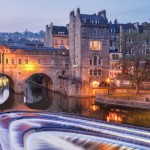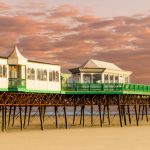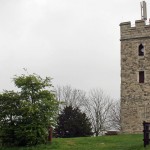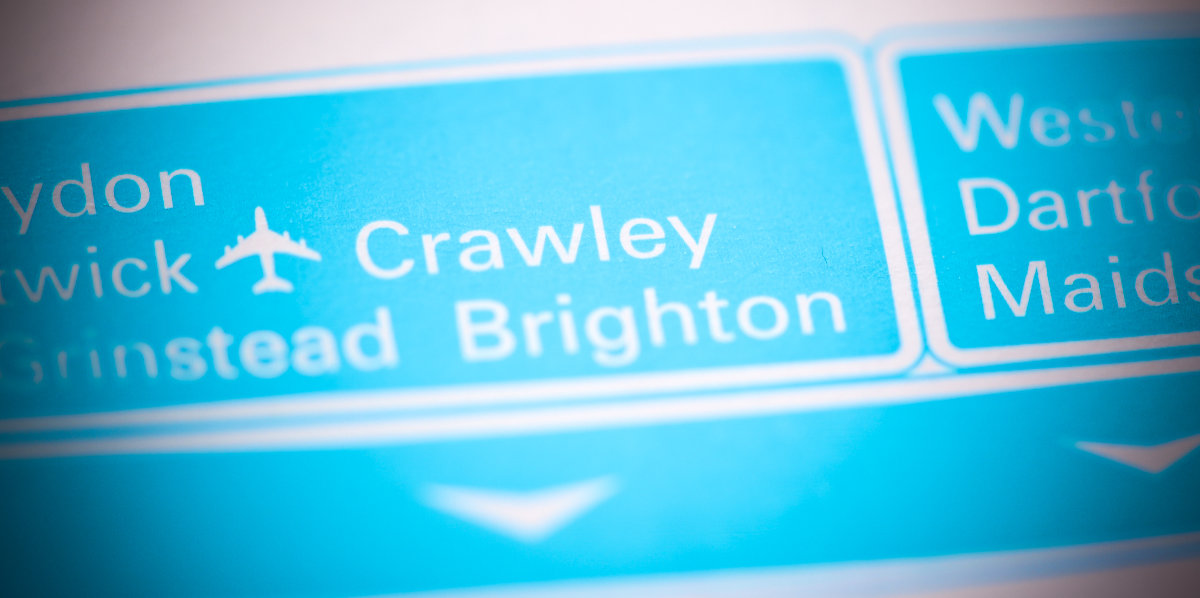
The Five Minutes Spare Tour of Crawley, The Town With That Airport!
Here at Five Minutes Spare, we often review towns and cities in Britain with the aim of highlighting their best points and showing you that there are worthy staycation destinations everywhere. Sometimes it’s not that easy to get the good across, but not with Crawley.
This old but recently expanded market town is more rainbow coloured than drab grey and it even has a decent football club, who are no strangers to pulling off Cup upsets. It’s also quite handy for Brighton and the coast if you want to add a seaside day to your visit.
Situated in West Sussex, this English town is about 30 miles from London and can boast of having the internationally renowned Gatwick Airport within its bounds. This puts it in the demographic of English residents that still get the potholes fixed in the roads and that those north of Watford are envious of.
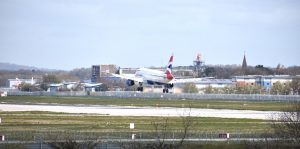
Image: Rich Higgins/Shutterstock.com
Anyway joking aside Crawley has been inhabited since the Stone Age, which seems like a good place to start with, in terms of history anyway. Let’s turn the clock back to when the dinosaurs had only just died out and the first ‘men’ were walking the earth and begin our Five Minute tour…
Stone Age Crawley
Although now with a thriving population of around 106,000 people, early Crawley would have started as a few Stone Age families living in caves or holes in the ground. Flint shards shaped into arrowheads and other tools have been found to the south of town, indicating the presence of people as long ago as the Mesolithic period. That’s so old we had to go and look it up. It’s the mid-Stone Age, a few decades after the post-glacial period where Britain warmed up.
Later, after the temperature fluctuation had settled down a bit, we had the Neolithic inhabitants of Crawley, after which the Bronze Age saw even more people gathering here. This whole area of England is one of the most densely populated and it has been for a long, long time. They are perfectly situated between London and the sea crossings. Besides anything else, this area was packed with iron which made it vastly popular during the Iron Age.
Here Come The Romans
So, fast forward a few thousand years and the Romans arrive, around 40AD. When they get to Britain, Sussex is one of the first places they arrive in. While there, they realise there are lots of minerals in the ground and they start extracting, too. Before you know it, furnaces for smelting spring up all over the area. They are close enough to the shores that the resources can be shipped back to Rome, yet far enough inland that they are protected from the Vikings, who are only a few centuries away.
The Romans retreated sometime around the 3rd century. The Saxon’s who lived there afterwards were probably a mix of Roman and native breeding. In the 5th century, these Saxons named the place Crow’s Leah – as in a wood that is infested with crows – and the name stuck.
When the Vikings were raiding in the 9th and 10th centuries, Crawley would have been largely untouched. It may have been raided by the landed Vikings. In the 1086 Domesday Survey, Crawley has three different listings, none of which are in the correct area. We can only assume that the settlement was therefore too small to be of any notice. It is strange, however, that this patch of land so close to London is unaccounted for.
The Market Is Open
In the 13th century, Crawley was given a town charter granting them permission to have a market there every week. This allowed the town new powers of trade, letting them run a fayre every year. Traders would have come from London and from the ports in the south, to meet in Crawley as a halfway point.
This was reaffirmed in 1770 when a turnpike was added to the roads to make travel easier. For the next hundred years, the town operated as a centre of trade made prosperous by providing a meeting place for traders. They had a large coaching inn, saw plenty of tourists heading to the coast, and had a bit of a reputation as being a quaint little stopping point in the country.
We’ll pause in the history a moment. As fascinating as it is, it’s time for some trivia, instead.
Crawly Trivia Favourites
Each town is unique, sporting its own array of dos and don’ts. Before you stick your foot in your mouth during your visit to Crawley, let Five Minutes Spare give you some talking points. Here are our favourite fun facts about Crawley:
- It’s estimated birthdate as a town is 470 AD.
- According to My London, Crawley has 104 listed buildings, each of which is worth their weight in tourism gold. We will cover some in a few.
- By the end of the 16th century, there were more than fifty forges in the area. The trend for extracting minerals was started in the Stone Age with flint but continues to this very day.
- Our favourite fact by far is that a 17th-century newspaper report claimed a dragon lived in the nearby St. Leonard’s Forest.
- The oldest building in this merry little town is St Nicholas’s Church, which was built by the Saxons in the tenth century.
- Crawley’s twin is the historical town of Dorsten in Germany. This has been ongoing since 1974.
There are loads of other little details that make this place particularly awesome. The only way to find out about them all is to visit and see for yourself.
The Industrial Age in Crawley
To turn our attention back to the history, then. The Industrial Era is when Crawley really picked up. As you can imagine, it was already a stopping point between London and Brighton. With the addition of the railway in the mid-1800s, this opened them up to real possibilities of tourism as a layover town.
On top of tourism, that mineralisation became vital for fuelling the Industrial Era. The machinery that worked the factories and mills was created from ore mined in places just like Crawley. They already had the furnaces, the forges and the ironsmiths. It was a natural progression to step up to fill that niche.
By 1848 a second railway stop had been added and in 1861, a full quarter of the population is recorded as being railway navvies, or otherwise working on that crucial Brighton to London line.
As of 1901, the population had only just surpassed 4,000 people. Compared to other industrial era towns, this was still reasonably small. The main products of the town focused on construction work, with a large builder being a major employer for most of the industrial years. The late 1800s saw piped water, gas, and electric street lighting reach this part of Sussex. Remember, the closer you were to London back then, the faster civilisation seemed to reach you.
At the start of WWI, Crawley saw the same death tolls that the rest of Britain was exposed to. Although small in population, the town had been thriving. New housing had been added which managed to steer the town away from the slum feel that other industrial era boomtowns had. It was small and perfectly preserved even through WWII.
The New Town of Crawley
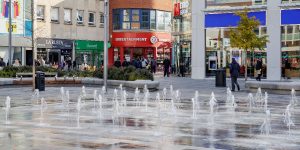
Image: Philip Bird LRPS CPAGB/Shutterstock.com
In 1947, the cities were bursting at the seams. Those that did come back from the war filled their craving for comradery by moving to the towns and cities. Families were crammed five to a room and the government in London needed somewhere to put the overspill. The extensive bombing throughout the UK had created a need for true diversity in towns. London answered by creating New Towns all over the country, then moving the population there.
Crawley went from 9.5k to 40k of people almost overnight. What was once a sleepy, historic town, was suddenly thronging with life. Almost 6,000 acres were set aside for new housing, which was thrown up in a hurry. After fifteen years the transition into New Town was officially complete.
Relocations were finished and refurbishments were over. Although the original plans were for the town to grow by around 50,000, it ended up with a current population of more than 100,000. This was because of a ruling back in the 60s that saw plans permitted that would hold a maximum of 120,000 people eventually. That day has yet to come, but we live in wonder.
The Swinging 60s
The 60s saw massive shopping expansion too. The town’s railway station was moved to account for this. Most of the town worked in the industrial sector with plenty of factories presenting employment opportunities.
Since it became a New Town, Crawley has become a confusing mass of different suburbs, each with their own identity as former towns and villages. Most of the areas are named for the town’s Iron foundry heritage, with plenty of construction at any given time. The modern town has a rich history, the result of more than ten thousand years of habitation. It is likely that Sussex will still be occupied in the event of a nuclear holocaust. It doesn’t seem to be going anywhere soon.
With the history rounded up to the nearest hundred years or so, we can move on. Are there any famous people from Crawley? Let’s take a look…
Famous People from Crawley
Without further ado, here are some of the Five Minutes Spare favourite famous people from Crawley:
- The boxer Michael Alldis is from Crawley.
- The Cure – the whole Cure – came from here. Hats off to Crawley for that one.
- Several cricketers, including Ben Brown and Josh Fleming.
- Brad Hall… Bobsledder.
- Helen Young, weathergirl, is from here, too.
There are loads of them, which is surprising for an area known for mineral extraction. Crawley is close enough to London for it to act as a commuter town, which is why it has such a diverse range of well-known people hailing from it.
Thinks to Do & See
We have reached that part of our tourists’ guide where we list some of the things that make this place so attractive as a day trip or staycation destination. Let’s do our bit for British tourism by listing all the best bits, right here.
Sports and Recreation
A New Town and therefore refurbished, there aren’t as many historic sights in the town as you might think. One of the biggest landmarks in town is actually the football stadium, known as Broadfield Stadium, which serves the Crawley Town FC. You can visit on match days or take a tour of the stadium in non-Covid times.
There are loads of things to do in Crawley if you have kids. We put this down to it being a New Town with lots of youngsters in it. In terms of sports, we already covered football but there are others in town. Crawley has its own community RUFC team, for example. Although rugby is a popular English sport, it isn’t the only one that people play.
Every English or Scottish town seems to have a golf club. Usually at least one but sometimes two or three. Crawley has three within a ten-mile radius. Check out the Ifield Golf Club, the Tilgate Forest Golf Club, to the Cottesmore Golf Club. All of which will let you play for a fee if you are visiting.
Historic Sights and Landmark
Of late Crawley seems to be in a constant state of redevelopment and even the Town Hall is due for demolition! Still, that’s not always a bad thing and it doesn’t mean there is nothing old to see here. In fact, there are over 100 listed buildings in the town, including three which are Grade 1 Listed.
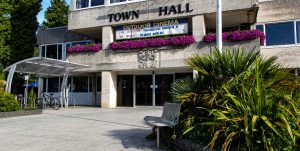
The town hall as it was – by the time you read this it will be probably be gone. Image: Malcolm T Walls Photo’s/ Shutterstock.com
If you like old-style architecture then the following are worth checking out:
Ifield Friends Meeting House
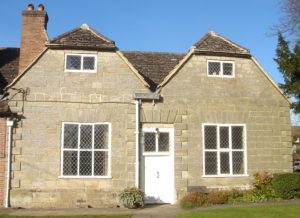
The Voice of Hassocks, Public domain, via Wikimedia Commons
This dates from 1676 and is one of the oldest Quaker places of worship still standing.
St Margaret’s Church
The present building incorporates the chancel from a 13th-century church which may have replaced a wooden building of two or three centuries earlier. Additions in the 14th century included stone effigies representing a knight and his wife, considered to be excellent examples of such sculptures. More structural changes took place at regular intervals, and a major Victorian restoration by architect Somers Clarke included an extension to the nave and a new tower. English Heritage has listed the church at Grade I because of its architectural and historical importance.
The churchyard has many old tombs and monuments, including writer Mark Lemon‘s grave and an elaborately decorated table tomb, which is listed separately by English Heritage at Grade II. Further memorials adorn the interior walls. Internal fixtures include a 12th-century font with unusual decorative carvings.
St Nicholas Church
St Nicholas Church is one of the oldest churches in the country and has been a place of Christian worship and devotion for well over 1000 years. It is known that the church is of Anglo-Saxon origin, and parts of it have been dated to between AD 950 and 1050!
You will also find that the Central Sussex College dominates the town’s landscape and invites young blood into the population.
Outdoor Attractions
To make up for the lack of historically relevant sites, Crawley sports a vast array of outdoor attractions. The good thing about the New Towns is that they are generally better planned than other cities. They have specified green spaces which help the green belt stay intact and they have been ergonomically designed to work with people, not against the flow.
Thus, Crawley has more than its fair share of outdoor attractions and things to do. There are adventure-seeking firms such as Southern Pursuits who will help you to explore more. There are also lots of parks that are free to visit and don’t ask you to leave a review afterwards. Tilgate Park is a favourite. This is a large area of cherished woodland with a lake that weaves in and out of the trees.
If you would prefer more space to wander in, try the Buchan Country Park instead. This is a natural area of conservation which helps form a green corridor through the area. It sports 170 acres of beautiful, natural green land. It’s a great place to take the kid’s ins summer and spend a day exploring. If this isn’t to your liking, you can always visit the Worth park instead. No? Then take a walk around the Crawley Memorial Gardens, instead. There are parks everywhere you turn in this town.
Another of the best attractions in the area is the Hawth, which is the local theatre. It’s a fairly impressive building and it’s where any big acts that come to town get to play. As well as being one of the biggest venues in town, they run an amateur dramatics group, engage youth in theatre, and run a dance studio. On its own, this place generates about 40% of the local’s entertainment.
Last but by no means least, you will find a Go Ape outdoor activity centre, just outside of town. This thrilling adventure playground features treetop worlds, swings and zip slides, Segway tours and so much more. If you are in the area on holiday you should add Go Ape to the itinerary.
Kids Entertainment in Crawley
As we mentioned before, there’s a ton of things to do in Crawley if you are trying to entertain kiddies. One of the best known is the Cherry Lane Adventure Playground. Just about every child that has grown up here since the early 00s has had the experience of playing here on a Saturday or Sunday. This place was originally designated from a wasteland back in the 50s but has come such a long way it’s now unrecognisable as an outdoor play area.
If you want to join a gym with kids, then K2 in Crawley lets you do that. They have an Olympic sized swimming pool in the same space as group fitness studios, a 12-metre climbing wall, and a sports hall. They also have tennis courts for hire if you want to try your hand. Their motto is that everyone in the family be active. We love the idea but can’t say that we share the enthusiasm…
As well as the Cherry Lane playground, there is the Waterlea Adventure Playground in Crawley, too. Found on furnace place, this is an outdoor play area that is bookable for children’s parties. It is part of a government-run branch of adventure playgrounds aimed at 9–16-year-olds. They seek to make it a safe, friendly, fun space – and they do a pretty good job.
Shopping and Retail
The best shopping in town can be had in the County Mall Shopping Centre, but keep in mind that the whole town centre was extended several times just to accommodate the extra shops. The main road through Crawley has a Tesco Superstore at one end and an Asda superstore at the other… it really is like a war of the shops.
Galleries and Museums
Crawley has its own museum which is imaginatively named “Crawley Museum”. The whole history of the town is recorded here, and you might get to see some of the flint arrowheads found here that date back to those prehistoric times.
The other branch of this local museum is on the Ifield millpond nearby. The Ifield watermill was in operation from as early as 1274. Restored in the 70s, this special area of preserved industrial history is one of a kind. It has a working waterwheel and plenty of other mechanical instruments which can’t be seen anywhere else in the area. If you want to learn about your industrial heritage as an English person, this is the ideal spot.
Other Notable Crawley Attractions
There are so many things to do in town that we had to add a section for the things we missed out on. Considering not going into too much detail, here are some of the other sights you should try and see if you are spending a holiday in Crawley:
- There are a few different escape room experiences in town for those looking for team building in Crawley. See the Hounds Escape Games Experience company or the Tulleys Escape Rooms and Games company for more.
- Alexander House is in the area, and although you can’t go for a wander of the grounds, they do run a spa from here. A lovely way to treat yourself for a day if you are on holiday.
- There are lots of corporations in Crawley, you can tell by the paintballing in the forest, the team sport indoor go-karting company, and Yoga retreat.
- There’s a Cineworld, everyone loves a Cineworld. We wonder how the world will respond to the lack of cinemas in the coming months.
And finally, let’s not forget that there are express bus and train services from Crawley town right into Gatwick Airport. There are a fair number of hotels and B&Bs in the town as a result. It’s a tourist’s haven really. On one end of the line, you have the bright lights of London. On the other end of the line, you have the beaches of Brighton.
How to Get To Crawley
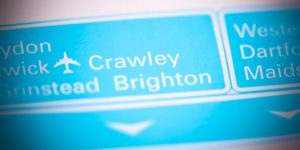
Crawley. United Kingdom on a map
We have shared all there is to know about Crawley at this point. Sussex awaits your exploration – and here is how to get there…
By Road
If you follow the M23 north out of Brighton, or south out of London, you’ll hit Crawley.
By Rail
Crawley railway station is on the London Bridge line.
By Air
London Gatwick airport is your nearest by air and actually falls with the town’s boundries.
By Sea
Alas, you are landlocked.
Got Five Minutes Left?
If you are looking for ways to fill your time, then we here at Five Minutes Spare are happy to help. Browse our pages for top tips on where to book next summer’s holiday in the UK or follow us on Facebook to keep up with all the recent news.

